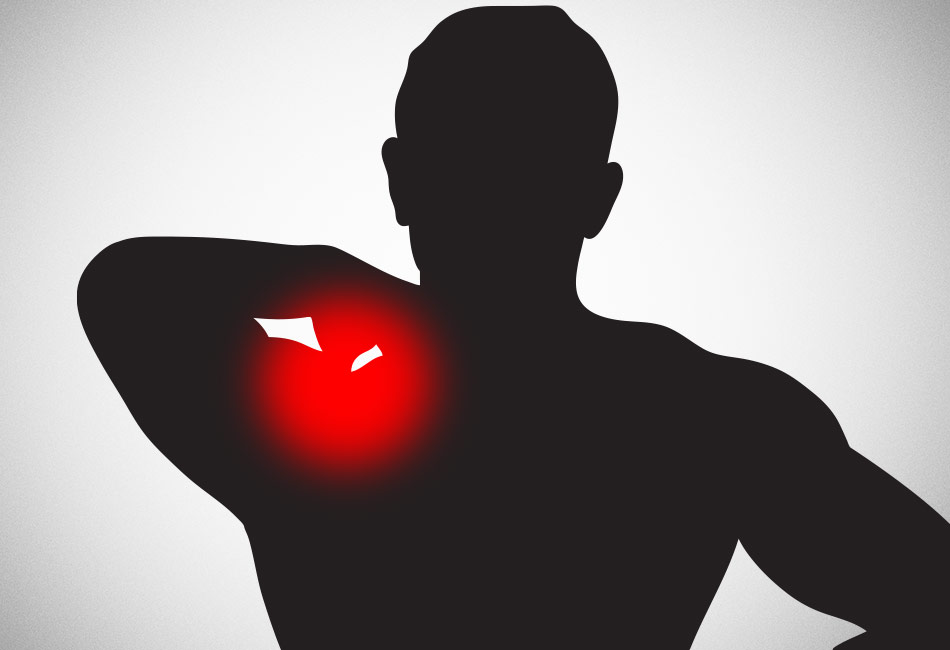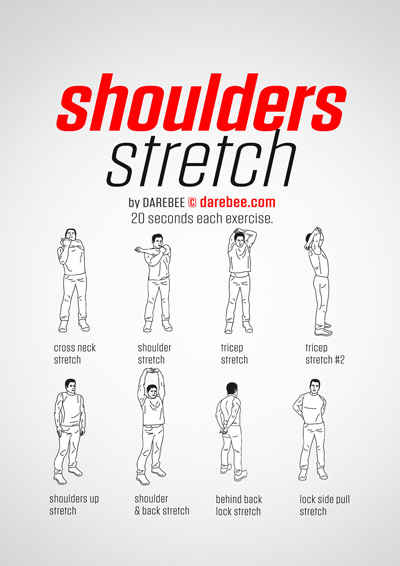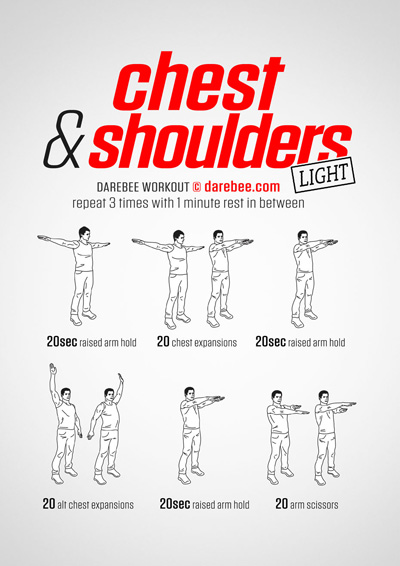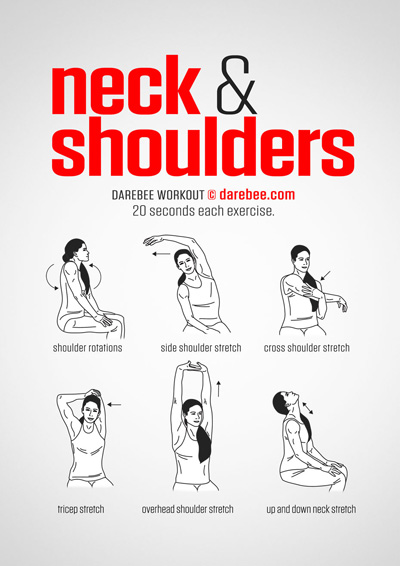The shoulder joint is one of the most complex joints in the body. It is actually made up of two separate joints, the glenohumeral and acromioclavicular joints, which work together as one to produce the most flexible joint in the body.
Both the glenohumeral (ball and socket joint where the humerus bone of the arm meets the scapula) and acromioclavicular (upper shoulder joint where the clavicle meets the scapula) are held together by a dense network of muscle, cartilage and tendons. This means that over time wear and tear and the wrong kind of exercises can affect this tight network creating issues in the shoulder that range from mildly annoying to extremely painful.
The picture gets even more complicated when we realize that the shoulder joint itself is intimately connected to all major upper body muscles and its range of motion is powered by them. That means that a shoulder injury is easy to occur and when it does it affects almost every kind of upper body movement you can imagine.
In the 21st century our understanding of injuries is governed by three distinct approaches: tendinopathy, pain and symptom modification testing. To understand what’s different in this approach it’s important to look at what used to happen traditionally. A sports injury would lead to a number of examinations designed to determine the specific site of the injury (what most sports injury specialists call the “site pathology analysis”). The problem with that is that a lot of the clinical tests available do a relatively poor job at determining the exact type or locale of an injury because they lack specificity or sensitivity. This left the professional treating such an injury with a limited range of choices that were generic rather than specific.
Here’s how modern sports medicine approaches injuries today:
- It’s the tendons. While in most cases injuries involve muscle tear or even rupture the root cause often lies in weaknesses or instability in the tendons that anchor them and support them. By addressing that need first during rehabilitation muscles are given a better chance at successful recovery. This is true for complex joints like the shoulder where the network of tendons plays such an important part in its operation.
- Pain pathways. Pain in a shoulder injury arises out of two primary sources. The stimulation of nerves (called nociception) and the output of the brain. That means that it is usually poorly related to structural damage that has occurred in the shoulder, for instance. Tracing the pain pathway and understanding exactly where it comes from and what’s causing it is key to understanding exactly what treatment to apply.
- Symptom modification testing. An injury in a complex joint like the shoulder responds best to tests that identify the exact painful movement involving the joint and then work to modify that through a series of rehabilitation exercises. Symptom modification testing is one of the most promising areas in sports injury rehabilitation, at the moment.
These three approaches have some overlap. But what is most significant about them is that they remove the guesswork out of a sports injury and target the specific pathways through which a joint works. Even better news the approach makes it easier to find exercises that help successfully rehabilitate an injured shoulder joint.
Exercises to Rehabilitate Your Shoulder Joint After an Injury
If you have injured your shoulder joint what should be your first steps to rehabilitation? This is important when you don’t have access to a professional and cannot undertake supervised treatment.
- Diagnosis. You will need to diagnose yourself where the injury lies and its severity by gently articulating your shoulder, arm fully extended. Take your arm through a full range of motion, raising it to the front until it is over your head, to the die until it over your head. Then repeat this time with the palm of your hand facing upwards. You are looking to identify the point at which pain occurs and the area in which it makes itself felt, plus the degrees of freedom of movement still available to you. There is an online self-diagnosis tool that can help you by making sure you are at least looking in the right direction. It can be found here.
- Rest and Conditioning. Depending on how recently you injured your shoulder you will most probably need to factor in a week or so of relative inactivity to give the joint tendons the opportunity to recover from any inflammation. Once that happens your rehabilitative efforts will include both rotator cuff strengthening and tendon conditioning.
Because the shoulder joint is so complex and it is affected by so many other factors not directly linked to it such as the condition of your core abdominals and the strength of your biceps your rehabilitation exercise regime will be tailored to the extent of your injury. It is important to customize the exercises listed below to suit your needs. The suggested sets and repetitions are there to guide you. Depending on the movement and position that causes pain and stops your shoulder joint from functioning properly you may want to give more or less focus on one or more of them and work the one that will most benefit you. Some type of shoulder joint injury can, however, benefit from doing all three.
External Rotation
Stand with your back against a wall, make sure that your body and shoulders remain straight. Bend your elbow to form a 90-degree angle and bring your arm across your abdomen and keep your thumb upright and your palm flat against your stomach. Perform an external rotation by moving your arm and forearm away from the abdomen, remember to keep your elbow bent. Continue this external rotation until the back of your arm is flat against the wall. Hold this position for five seconds and rotate your arm back to the starting position. Perform one set of 10 repetitions on both arms.
Supraspinatus Stretch
You will need two dumbbells to perform this exercise. Stand upright and holding a dumbbell in each hand with thumbs pointing down. While keeping your elbows straight, slowly bring your arms outward to form a 45-degree angle. Hold this position for five seconds and slowly return to the starting position. Perform three sets of 20 repetitions, once daily to strengthen the muscles and tendons in the rotator cuff to help stabilize the shoulders and restore mobility.
Triceps Stretch
Stand upright and place the palm of your hand as far down your back as you can. Use your other hand to grab your elbow and gently pull that arm down behind your head. Continue this gentle pull until you feel a stretch in your shoulders. Hold this stretch for five seconds and relax. Perform one set of 10 repetitions on both arms, two to three times a day to stretch the tendons and joints in the shoulder and help restore your range of motion.
Scapular Squeezes
Lie face down with your arms to the sides at shoulder level, elbows bent at 90 degrees. Keep your arms at shoulder level and raise them off the floor as far as you can squeezing your shoulder blades together. While performing this exercise, try to not shrug your shoulders and remember to relax your neck. As you perform this exercise, the lower muscles between your scapula should be contracting. Hold each shoulder blade squeeze for five seconds and relax. Perform one set of 20 repetitions three times a day to strengthen the muscles in the shoulders and prevent further injury.
Remember that good shoulder injury rehabilitation requires five critical components:
- Sports-specific technique – work slowly through the technique of your sport of choice to test whether the pain levels experienced are dropping and whether mobility is slowly coming back to your shoulder joint.
- Flexibility – flexibility on your shoulder joint will now have to be part of your on-going regime.
- Core stability – A strong core allows the trunk muscles to transfer kinetic energy to the shoulder for overhead activities. You should ensure that your core is strong by regularly doing core-strengthening exercises.
- Rotator-cuff control – Strength and flexibility work performed on the shoulder joint is required to ensure that the muscles and tendons that make it up are perfectly balanced.
- General strength - Once the essential issues of technique, flexibility, core stability, and rotator-cuff control are being implemented, we then should also look at the periphery of the body to make sure that muscular imbalances do not create the conditions for fresh injury.
By following the exercises detailed here and establishing a workout routine that creates balance in muscle groups to the front and back of the body, the outer core and the inner core, you reduce the likelihoods of reinjuring your shoulder and make it harder to get injured in general.
DAREBEE Workouts To Help You:
Arms & Shoulders Stretch
Sources
A kinematic and electromyographic study of shoulder rehabilitation exercises
Shoulder rehabilitation: principles and practice
Shoulder Muscle Activity and Function in Common Shoulder Rehabilitation Exercises
Eccentric training in chronic painful impingement syndrome of the shoulder: results of a pilot study
Stretching and strengthening exercises: Their effect on three-dimensional scapular kinematics
Frozen shoulder: a long-term prospective study
Rehabilitation of Scapular Muscle Balance Which Exercises to Prescribe















